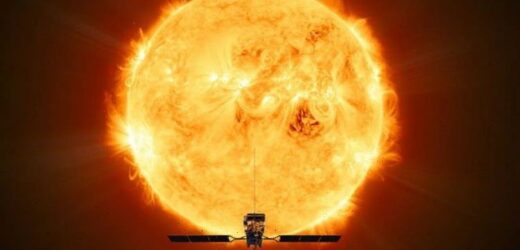Solar Orbiter: ESA release footage of solar flares
We use your sign-up to provide content in ways you’ve consented to and to improve our understanding of you. This may include adverts from us and 3rd parties based on our understanding. You can unsubscribe at any time. More info
Solar Orbiter may not be the first spacecraft to study the Sun, but it is certainly the most sophisticated bit of kit we have launched into space to date. Built by Airbus in Stevenage, Solar Orbiter will scrutinise the Sun in minute detail on a “world-class mission” unlike anything that came before it. Armed with a wide array of instruments, the space probe was launched by NASA on February 10, 2020, and is now rapidly approaching Venus.
The mission’s primary goal is to study how the Sun creates and controls the dynamic conditions within the heliosphere.
The heliosphere is the region of space surrounding the Sun and solar system that is dominated by the Sun’s magnetic field and solar winds – streams of particles flowing out into space.
Next week (August 9), Solar Orbiter will perform a so-called gravity-assisted manoeuvre or GAM of Venus that will help it get closer to the Sun.
Eventually, after multiple laps of the system and a flyby of Earth in November this year, the spacecraft will be put into a position within Mercury’s orbit from which it will be able to observe the Sun’s polar regions.
Monday’s GAM will be the second time Solar Orbiter zips around Venus, after its first flyby in December 2020 – and the team behind the mission could not be more excited.
Dr Andrzej Fludra from RAL Space at the Rutherford Appleton Laboratory told Express.co.uk Solar Orbiter builds upon a long legacy of UK science missions that have come before but the data collected by the spacecraft will also serve as a foundation for generations to come.


Dr Fludra is in charge of an international consortium of scientists at RAL Space, that designed and built SPICE – one of Solar Orbiter’s key instruments.
Described as something of a “big thermometer”, SPICE is a high-resolution spectrometer designed to operate at extreme ultraviolet wavelengths.
SPICE will help scientists learn more about the properties and composition of solar plasma while matching and comparing its findings to the other nine instruments aboard the space probe.
Solar Orbiter carries a total of 10 experiments – six remote sensing instruments or telescopes to observe the Sun and four in-situ ones to measure the conditions around the spacecraft itself.
The instruments complement and support each other, which makes Solar Orbiter stand out from similar missions.
Dr Fludra said: “We are incredibly proud of this, to build the entire spacecraft fit for this journey towards the Sun, to withstand the heat and the conditions. That’s really a world-class achievement.”
Before Solar Orbiter blasted off into space, there was a whole host of spacecraft that have greatly contributed to the field of solar physics.
Solar Orbiter will 'take measurements of the Sun' says expert
Skylab, the first US space station launched in the early Seventies, included eight separate solar experiments, significantly advancing our understanding of how the Sun works.
Since then the Solar and Heliospheric Observatory (SOHO) has been one of the greatest instruments to watch the Sun.
For 25 years now, SOHO has been collecting real-time data on the star but has also helped detect more than 4,000 comets.
The launch of two STEREO spacecraft in 2006 was another key moment in the field.
The mission took stereoscopic images of the Sun that helped scientists better characterise solar phenomena like coronal mass ejections (CMEs) – large flows of plasma and magnetic field from the Sun’s corona.
All these missions that came before, defined the era they were in – the Seventies, the Eighties, the Nineties.

Dr Fludra believes Solar Orbiter will be the spacecraft that will define the field in the years to comes, all thanks to the incredible scientists and engineers from the UK and partnering nations who collaborated on the project.
He said: “It’s a top achievement using all of our previous knowledge and expertise in engineering and science.
“Every decade has its own ‘best’. SOHO was absolutely the best in the Nineties, that was the top of the range mission and instruments.
“Then STEREO, when they were launched in the mid-decade of the Noughties, they were the best.
“And of course, today it’s our turn to be the top.”
The Solar Orbiter is a joint venture between the European Space Agency (ESA) and NASA, as part of ESA’s Cosmic Vision Programme.
The UK lead the construction of the SPICE instrument, which was funded by ESA and the UK Space Agency.


UK contributions to SPICE included the development and building phase by the large team at RAL Space – now part of the international SPICE operations team.
In particular, Dr Fludra said one of the detector subsystems was “was designed and built by our world-class experts on camera electronics at RAL Space” and funded by the UK space agency.
The majority of the funding, however, was provided by ESA between 2012 and 2020 with contributions Germany, France, Norway and Switzerland
Dr Fludra and his colleagues have been working on the project for 10 years now and he said they still live and breathe the mission every day.
Solar Orbiter is expected to come as close as 0.3au of the Sun – only 27.8 million miles away or about a third of the distance to Earth – by the year 2029.
But the spacecraft has already made some breakthroughs.
When Solar Orbiter beamed back its first images of the Sun last year, scientists were able to detect thousands of miniature flares popping up on the Sun’s surface like “campfires” or “fireflies”.
The discovery could help understand how the Sun drives space weather events.
And Dr Fludra believes Solar Orbiter has what it takes to break new scientific ground.
He added: “Having spent almost 10 years building and testing the instrument, we are proud to be part of this mission.”
The Sun’s behaviour can have a profound effect on Earth, especially if it leads to solar storms.
These can disrupt satellite operations and affect communication satellites, possibly even rendering them useless.
Scientists, therefore, believe it is vital to learn as much as we can about the Sun to help us prepare for these incidents – and the UK-built Solar Orbiter is the right tool for the job.
Source: Read Full Article


